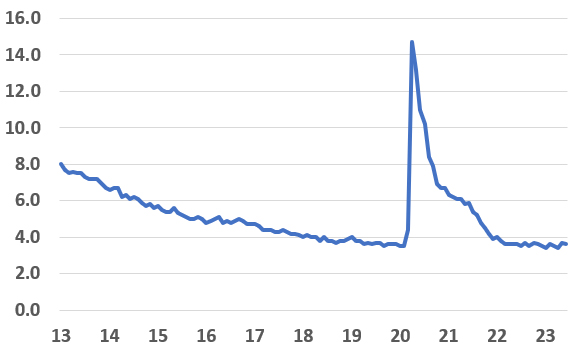Thursday, July 13, 2023
Champing at the bit – that’s what lots of people who employ humans to get their work done are doing right now. Champing at the bit to take over the driver’s seat from the workforce who’s wearing a hole in the upholstery. A CEO I spoke with last month said, and this is a direct quote – I’m not embellishing, “I can’t wait until we can treat our employees the way we want to, rather than the way they want to be treated.” There’s so much to unpack there.
With one reprieve (that was totally not worth it) for about a year and a half, starting in March of 2020, employers have been behind the eight ball on the labor supply and demand table for most of the last ten years. And most of them are over it!
The problem is… the population demographics are not.
This question persists: “Where did all the workers go?” The answer? By and large, they didn’t go anywhere. They never existed in the first place. And they won’t, in sufficient numbers, for some time to come.
Still, many employers celebrated the July 7, 2023 news that hiring had slowed in June for the first time in months and somehow saw this as a sign that they could relax whatever measures they might have put in place to attract and retain talent.
Not so fast…
To take comfort in the idea that the situation has “cooled”, as some sources put it, is like rejoicing over a heat index of 105°F (41°C) because it’s better than 108°F (42°C). The economy still added more than 200,000 jobs, with no new sources of people to fill them.
Speaking of unforgiving numbers, the US unemployment rate, a highly reliable predictor of the ease with which you’re able to staff your operation, was on a steady downhill slope from 10 years ago until the pandemic. (In general, lower unemployment means greater staffing pain.) And since the start of 2022, when it returned to pre-COVID lows, the unemployment rate has varied only slightly between 3.8% and 3.4%, the lowest rate in 54 years. No wonder it’s hard to find and keep workers.
US Unemployment Rate, 2013 – June 2023

Source: US Department of Labor, Bureau of Labor Statistics
The June rate stubbornly slipped again, to 3.6%, as job openings decreased by a drop in the bucket, to 9.8 million. Meanwhile, the percentage of workers who voluntarily quit their jobs rose again, to 4%, suggesting that workers are still confident and exercising their ability to seek the best overall deal. Alas, the Great Resignation may be greater than we thought.
Here’s a sobering fact. IF (huge “if”) every unemployed person in the US (fewer than 6 million) went to work today, we’d still have a problem. A big problem.
And I feel really bad if I’m the first to tell you this, but it’s not going to get any better any time soon.
According to the Conference Board, the working age (15 – 64) population in the US is at a historic low, relative to the population as a whole and will remain flat, except for a few small dips, from now until 2030. And no meaningful relief will be felt until 2035. Sorry. My wife and I did our part. But since 1988, when our first child was born, there just haven’t been enough new people, by birth or immigration, to meet the country’s labor needs.
The bad news (oh wait… you mean the forgoing wasn’t the bad news?): there simply aren’t enough people (and there won’t be for a while) to go around for every employer. Get used to it.
The good news: there ARE (and will be) enough for the very best employers. So that’s where you have to be.
As we postulated in our book, Contented Cows STILL Give Better Milk, motivated people move faster. Employers that look like the following will STILL have the upper hand in finding and keeping the best:
- Value people as an investment, not a cost
- Treat workers with dignity and respect
- Have competent leaders who know how to harness the willing and enthusiastic engagement of everyone on the payroll
- Create a culture where people say “I GET to go to work”, not “I HAVE to”.
- Maintain high standards of performance, attainable through honest feedback
- Enable their workers to do their best work
- Listen, really listen, to their workforce
- Look for ways to make work FUN
- Invest heavily in the development of the people they’ve hired
- And above all – really CARE about their workers as living, breathing humans, with needs, families, passions, and lives beyond the workplace.
While we can’t magically create fully grown workers in the short term, employers with a people-first strategy (it’s gotta be more than a philosophy) consistently fare better – far better – in the war for talent. Always have. Always will.